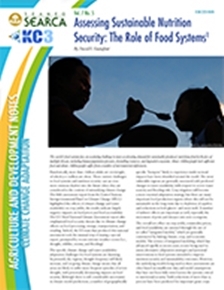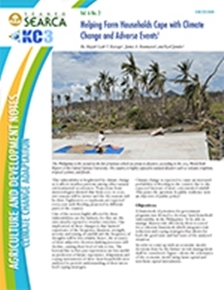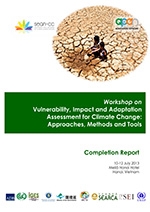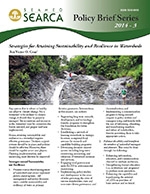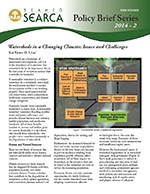SEARCA Publications
The world's food systems face an escalating challenge to meet accelerating demand for sustainably-produced, nutritious food in the face of multiple threats, including human population pressure, dwindling resources, and degraded ecosystems. About 1 billion people lack sufficient food and about 2 billion people suffer from a number of micronutrient deficiencies. Paradoxically, more than 2 billion adults are overweight, of which 500 million are obese. These current challenges to food systems and nutrition security cast an even more ominous shadow into…
The Philippines is the second on the list of nations which are prone to disasters, according to the 2014 World Risk Report of the United Nations University. The country is highly exposed to natural disasters such as volcanic eruptions, tropical cyclones, and floods. This vulnerability is heightened by climate change as it affects weather patterns among other natural environmental occurrences. Projections from meteorologists showed that from 2020 to 2050, wet seasons will be wetter and the dry seasons will be…
Twelve technical officers and two executives from the focal Climate Change offices of seven Southeast Asian countries completed the workshop on Vulnerability, Impact and Adaptation Assessment (VIAA) for Climate Change: Approaches, Methods, and Tools on 10-12 July 2013 at Meliá Hanoi Hotel, Hanoi, Vietnam. The officials and technical staff come from Cambodia, Indonesia, Lao PDR, Malaysia, Philippines, Thailand, and Vietnam and belong to the Southeast Asian Network of Climate Change Offices (SEAN-CC) of the United Nations Environment Program (UNEP). Co-organized…
The tool for understanding resilience of fisheries (VA-TURF) is a practical and cost-effective tool for assessing the climate change vulnerability of coastal fisheries in the tropics (Mamauag, Aliño, Martinez, Muallil, Doctor, Dizon, Geronimo, Panga, and Cabral 2013). Developed by local marine scientists at the Marine Science Institute of the University of the Philippines Diliman, VA-TURF aims to identify vulnerable fishing communities and demonstrates how to link vulnerability assessment results to climate change adaptation. The results are inputs to drafting of…
Assessment, monitoring, and evaluation are integral parts of climate change adaptation (CCA) planning and implementation. Assessment activities contribute to defining indicators, baselines (situations at the beginning of the intervention), and baseline projections (without intervention). On the other hand, M&E activities set baselines, define indicators, measure progress, and evaluate successes and setbacks in adaptation interventions. Designing a Monitoring and Evaluation (M&E) System is therefore challenging, particularly when deciding which indicator will match with a particular goal to measure project success.
Climate variability and weather fluctuations are important risk factors in crop production. They have caused reduced yields and significant reduction in crop production throughout Southeast Asia. As a risk management strategy, crop insurance has been promoted in risk-prone areas in the region to reduce the adverse impacts of climate hazards. However, crop insurance products have not been very popular among farmers and crop growers due to limited coverage amidst high premium as well as apparent subjectivity and bias in crop…
Agriculture is a key sector providing economic and social development in Southeast Asian countries, where a majority of the region’s population depend on agricultural production as a main source of household income. The implication of global environmental change has extended the agricultural agenda to respond to the drivers of climate change—in the context where agriculture is both a contributor to greenhouse gas (GHG) emissions and a possible mitigating factor through the adjustment of practices and the adoption of new technologies.
Any system that is robust or healthy can adapt to climate change. For a watershed to be resilient to a climate change, it should thus be properly managed. The ecosystems and resources in the watershed must be conserve, the forests restores, and proper land uses implemented. Hence, attaining sustainability and resilience in a watershed requires effective governance. Decision support systems should be in place, and policues should be effective. Moreover, there should be capable actors and players. Planning, implementation, and…
Watershed are landscape of interconnected ecosystems that provide a vast array of ecosystem services. A sustainable watershed is a resilient watershed. In A sustainable watershed, the mechanisms involved to sustain the ecosystems within it are working properly. These mechanisms include soil conservation, water conservation, biodiversity conservation, and climate change mitigation.
Coastal vulnerability assessment (VA) tools aim to provide guidance for coastal climate change adaptation (CCA) planning by measuring the vulnerability of coastal ecosystems to a variety of climate-related hazards such as changes in ocean temperature, sea level rise, and increased frequency of more devastating typhoons. The scope of coastal vulnerability assessment (VA) includes fisheries, coastal integrity, orthe overall state of the coast and biodiversity therein. The tools used are mostly ecosystem-based with biophysical and socioeconomic components. The scale of application…

